Michael Greger's Blog, page 9
December 19, 2024
Bone Fractures, Lung Cancer, and Vitamin B12 Supplements?
What do randomized controlled trials of high-dose daily vitamin B12 supplementation show about its effects on cancer risk, death, and longevity?
In 2019, “Association of High Intakes of Vitamins B6 and B12 from Food and Supplements with Risk of Hip Fracture Among Postmenopausal Women in the [Harvard] Nurses’ Health Study” was published. Note, though, that only the combined high intake of vitamins B6 (≥35 mg/day) and B12 (≥20 mcg/day) was associated with an increased hip fracture risk. We know that treatment with high doses of vitamin B6 may increase hip fracture risk on its own. After a decade or so, those who had been taking high-dose (40 mg) B6 supplements had about a 40 percent higher hip fracture risk, but not those taking B12, as you can see below and at 0:35 in my video Do Vitamin B12 Supplements Cause Bone Fractures and Lung Cancer?.

That’s what the Harvard study found, too. High intake of vitamin B12 alone was not associated with increased risk. In fact, some observational studies suggest a slightly lower fracture risk at high B12 blood levels. What we care about most, though, are interventional studies, where people are randomized to B12 so we can see what happens, and when we look at those, we find there is no increased fracture risk among those given B12. In conclusion, based on randomized controlled trials, high doses of vitamin B12 have not been shown to be associated with the risk of fractures.
Okay, but what about this? In 2017, a study found that men taking vitamin B12 supplements appeared to have increased lung cancer risk. Now, the researchers didn’t find any such association in women, and the increased risk was mostly among men who smoked. Could it be that B12 was feeding budding tumors? It’s hard enough imagining a vitamin being carcinogenic on its own, especially if it somehow only affects men and not also women. “Replication of these findings in additional prospective studies with careful measurement of B vitamin supplement use is warranted.” And, indeed, when you put together all the observational studies, there is no significant correlation between lung cancer and levels of B12 in the blood, whether you’ve smoked or not. If anything, most studies seemed to trend towards higher B12 levels being protective, as you can see below and at 2:03 in my video.
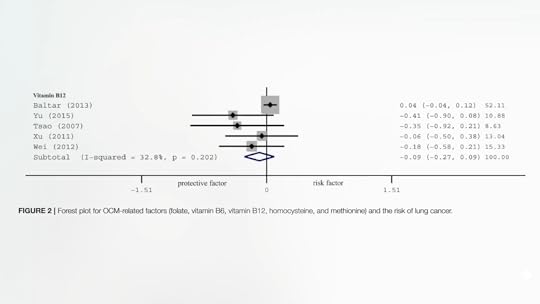
Then, in 2018, a new study found an association between overall lung cancer risk and higher circulating levels of B12, again appearing to be more of a concern with smokers, as seen here and at 2:16 in my video.

Now, this was another observational study. Those with higher B12 levels were just observed to have higher cancer levels. Those of you who have been following my work know the drill: There are two potential issues that arise in observational studies that prevent us from ascribing cause-and-effect: confounding factors, also known as “lurker variables,” and reverse causation.
What might be a lurker variable in this case? What might be a third factor associated with both higher B12 levels and cancer that may be the true cause? Well, who has higher levels of B12 circulating in their blood? Those who eat a lot of meat and dairy, which are, in fact, “the most important contributors to serum vitamin B-12,” that is, B12 in our blood. And those who eat more meat do tend to have more lung cancer: “Dose-response analysis showed that consumption of red meat for 120 g per day might increase the risk of lung cancer by 35%, and consumption of processed meat for 50 g per day might increase the risk of lung cancer by 20%.” So, we’re generally talking about 35 percent more risk for every quarter-pound burger eaten each day and about 20 percent increased risk for every breakfast sausage link. It’s no wonder those with higher B12 levels in their blood could have more lung cancer. The B12 could just be a marker for meat intake.
And, if you remember, reverse causation is when X may not lead to Y, but, instead, Y may lead to X. So, instead of high B12 blood levels leading to cancer, maybe cancer leads to high blood levels of B12. And, indeed, nearly 75 percent of patients diagnosed with cancer exhibit elevated B12 levels. So, elevated B12 levels may simply be a marker for cancer. Besides taking extra B12, there are all sorts of reasons your levels can rise, such as liver problems, kidney problems, bone marrow problems, and cancer, as you can see below and at 3:50 in my video. So, high B12 levels may just be a marker of brewing, but not yet diagnosed, cancer.

What about observational studies specifically linking B12 supplement use to lung cancer, though? Those could also be reverse causation: “The consequence of being at risk for cancer is that patients will engage in healthier behaviors, including taking multivitamins (reverse causality). The well-established causes, such as smoking, chronic obstructive pulmonary disease, and previous cancers, are the real lung cancer risks.” So, we’re left with this “chicken or the egg causality dilemma,” which is why, ideally, we need randomized controlled trials to see if there’s any cause and effect.
This became even more urgent with genetic evidence suggesting that those born with higher lifelong levels may be at increased risk. Thankfully, as you can see below and at 4:47 in my video, we do have randomized controlled trials—more than a dozen randomized controlled trials randomizing thousands of people up to 2,000 micrograms of B12 every single day for years, in fact.

The findings? “Vitamin B supplementation does not have an effect on cancer incidence, death due to cancer, or total mortality.” And this includes specifically looking at lung cancer, as seen below and at 5:02 in my video. In fact, if anything, vitamin B supplements may actually lower the risk of the most dangerous form of skin cancer.
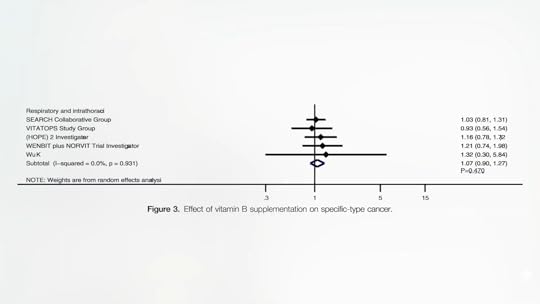
If you missed my previous video, check out Do Vitamin B12 Supplements Cause Acne?.
For my other B12 updates, see related posts below. All of these videos can be found in one digital download: Latest Vitamin B12 Recommendations.
I’ve also explored vitamin B12’s role in stroke risk. See the related posts below. That series is available for digital download, too: Why Do Vegetarians Have Higher Stroke Risk?.
December 17, 2024
Acne and Vitamin B12
Acne can be triggered in one in ten people who get vitamin B12 injections.
“Acne is a disease unique to humans.” Why do we even get it? Well, think about the distribution of those greasy sebaceous glands. They’re “on the face, chest and back; these are exactly the same structures that pose the greatest obstruction during childbirth…Having extra lubrication at these sites would help make the baby more slippery for birth conferring a selective advantage to successful delivery.” Perhaps, but what triggers them to become inflamed into pimples later in life?
“In westernized societies, acne vulgaris is a nearly universal skin disease afflicting 79% to 95%” of teens. Not even a single case could be found in some populations where more “traditional” diets are eaten (i.e., minimally processed, high-carb, low-fat diets). “Nutrition counseling” has been suggested “as a first-line or adjunctive therapy…for individuals with mild to moderate acne.” It looks like high glycemic foods and dairy products are “exacerbating factors,” so we’re talking about sugar, soda, refined junky carbohydrates, white flour, breakfast cereal, and dairy products, like milk, cheese, yogurt, and whey, as well as saturated and trans fats, which are concentrated in meat, dairy, junk, and fast food. You can see a table detailing this below and at 1:21 in my video Do Vitamin B12 Supplements Cause Acne?.
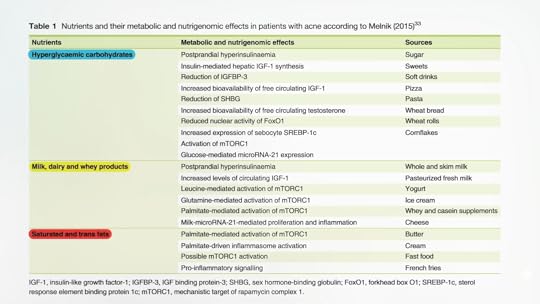
“Acne patients should be encouraged to discontinue any whey protein supplements they might be taking,” for example. “The relationship between milk and acne severity may be explained by the presence in dairy of normal reproductive [sex] steroid hormones or the enhanced production of polypeptide [growth] hormones such as IGF-1…” What if you gave up dairy a month ago and there’s still no change? “It should be noted that changes in acne due to any pharmaceutical treatment or dietary changes are likely to take at least 10 to 12 weeks,” so you have to stick with it.
“Acne patients,” not surprisingly, “were more than twice as likely to have a non-vegan diet compared with controls,” but the difference did not reach statistical significance. Were the vegans eating a lot of vegan junk? Maybe, but what about the paper entitled, “Vitamin B-12 Induced Acne”? Mammalian herbivores, including nonhuman primates like gorillas, and our fellow great apes, get all the B12 they need by practicing coprophagy, the eating of feces, but my preference would be to take B12 supplements. And you don’t have to worry about getting too much because it’s been reported that “there are no reports of adverse effects associated with excess B12 intake”—but that’s not true. First described back in the 1950s, acne erupts in about one in ten people within days or even hours of getting an injection of vitamin B12, which then disappears rapidly when injection “treatment is discontinued.”
At the time, we had no idea what the mechanism might be, and the problem remained unsolved until just a few years ago when we finally figured it out: Vitamin B12 modulates the gene expression of the skin bacteria that cause acne. Researchers swabbed the skin of ten people before and after being injected with vitamin B12. As you can see below and at 3:20 in my video, it turns out that the level of B12 on our skin is proportional to the level in our blood, so, after a B12 injection, the bacteria on our skin have to make less of their own B12. As a result, the acne bacteria could concentrate instead on using their cellular machinery to churn out more compounds to attack our face and “induce inflammation in acne.”
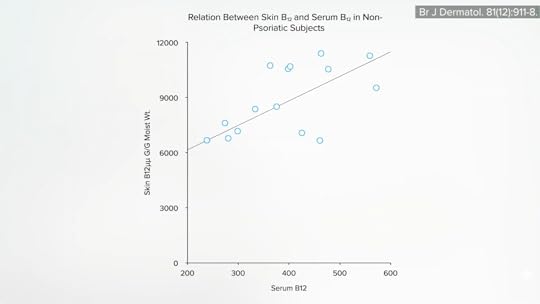
Indeed, as you can see here and at 3:53 in my video, without excess B12 on the skin (with B12 shown in green), the bacteria have to make most of it on their own at the expense of porphyrins (shown in red), which can trigger acne inflammation. When there is a lot of B12 floating around, the bacteria don’t have to waste resources and, instead, can focus on trying to pimple you up.

So, what do you do? We know that individuals on plant-based diets have to take supplemental B12, but we don’t have to get injections. Vitamin B12-related acne tends to occur only “in dosages in excess of 5 to 10 mg per week.” That’s 5,000 to 10,000 micrograms a week, which is well in excess of the 50 micrograms a day or, alternately, the 2,000-microgram single weekly dose that I recommend. The only time you should be taking 5,000 to 10,000 micrograms a week is if you are treating B12 deficiency. If you remember from my previous video, B12 deficiency is treated with 1,000 micrograms a day for a month or more, as shown below and at 4:35 in my video, and that could potentially trigger acne.

For example, a vegan woman who hadn’t been taking B12 developed a deficiency and had to be treated with such high doses of the vitamin that her face erupted in acne, as you can see at 4:49 in my video. All the more reason not to become B12-deficient in the first place. But, even if you do get B12 injections, the likelihood of it triggering acne may only be about one in ten.

For background and my updated recommendations, see my extended look at vitamin B12 in the related posts below. All of these videos can be found in one digital download. Check out Latest Vitamin B12 Recommendations.
I previously explored vitamin B12’s role in stroke risk, which you can also see in the related posts below. That series is available for digital download, too: Why Do Vegetarians Have Higher Stroke Risk?.
Up next is Do Vitamin B12 Supplements Cause Bone Fractures and Lung Cancer?.
December 12, 2024
Eating to Reverse Heart Failure
An entire issue of a cardiology journal dedicated to plant-based nutrition explores the role an evidence-based diet can play in the reversal of congestive heart failure.
It is a hopeful sign of the times when an entire issue of a cardiology journal is not just dedicated to nutrition, but to a plant-based diet in particular. Dr. Kim Williams, past president of the American College of Cardiology, starts his editorial with a quote attributed to the philosopher Arthur Schopenhauer: “All truth passes through three stages. First, it is ridiculed. Second, it is violently opposed. Third, it is accepted as being self-evident.” He goes on to write that “the truth (i.e., evidence) for the benefits of plant-based nutrition continues to mount.” We’ve got the evidence. The problem is the “inertia, culture, habit, and widespread marketing of unhealthy foods. Our goal must be to get the data out to the medical community and the public where it can actually change lives—creating healthier and longer ones.” That’s essentially my life’s mission in four words: Get the data out. Based on what we already know in the existing medical literature, “plant-based nutrition…clearly represents the single most important yet underutilized opportunity to reverse the pending obesity and diabetes-induced epidemic of morbidity and mortality,” meaning disease and death.
As I discuss in my video How to Reverse Heart Failure with Diet, the issue featured your typical heart disease reversal cases, including a 77-year-old woman with such bad heart disease that she couldn’t walk more than half a block or go up a single flight of stairs. She had severe blockages in all three of her main arteries and was referred to open-heart surgery for a bypass. However, instead of surgery, “she chose to adopt a whole-food plant-based diet, which included all vegetables, fruits, whole grains, potatoes, beans, legumes and nuts.” Even though “she described her previous diet as a ‘healthy’ Western one,” within a single month of going plant-based, “her symptoms had nearly resolved”—and forgot about walking a block. “She was able to walk on a treadmill for up to 50 min without chest discomfort or dyspnea,” becoming out of breath. Her cholesterol dropped about a hundred points from around 220 mg/dL (5.7 mmol/L) down to 120 mg/dL (3.2 mmol/L), with an LDL under 60 mg/dL (1.5 mmol/L). Then, four to five months later, she must have started missing her “chicken, fish, low-fat dairy and other animal products” and “returned to her prior eating habits.” Within a few weeks, with no change in her medications or anything else, her chest pain returned and she went on to have her chest sawed in half after all. After the surgery, she continued to eat the same diet that had contributed to causing her disease in the first place, then went on to have further disease progression.
Another case featured in the journal has a happier ending. It started out similarly: A 60-year-old man with severe chest pain after walking just half a block decided to take control of his health destiny and switched to a whole food, plant-based diet. “He described his prior diet as a ‘healthy’ diet of skinless chicken, fish, and low-fat dairy with some vegetables, fruits, and nuts”—a diet that had been choking off his heart. Within a few weeks, he experienced the same amazing transformation—from not being able to exercise at all to walking a mile, then being able to jog more than four miles (6.4 km), completely asymptomatic, off all drugs, without any surgery, and off to live happily ever after.
Now, of course, case reports are just glorified anecdotes. What we need is a randomized controlled trial to prove that heart disease can be reversed with lifestyle changes alone. Guess what? There was one published three decades ago, proving angiographic reversal of heart disease in 82 percent of the patients. Their arteries opened up without drugs and without surgery. So, these case reports are just to remind us that hundreds of thousands of individuals continue to needlessly die every year from what was proven to be a reversible condition decades ago.
The conventional use of case reports, though, is to present novel results in the hopes of inspiring trials to put them to the test. For example, consider this case report on a plant-based diet for congestive heart failure—not simply coronary artery disease. In this case, the heart muscle itself was so weakened that it couldn’t efficiently pump blood. It was only able to eject about 35 percent of the blood in the main heart chamber with every beat, whereas, normally, the heart can pump out at least 50 percent. And that’s exactly what the patient’s heart was able to do just six weeks after switching to a whole food, plant-based diet, which he chose to do instead of getting his chest cracked open. The researchers wrote: “To our knowledge, this is the first report of an improvement in heart failure symptoms and left ventricular ejection fraction following adoption of a plant-based diet.” It may be the first, but it isn’t the last.
Another case: A 54-year-old woman, obese and diagnosed with type 2 diabetes, presented with swelling ankles due to her heart failure. She switched from her regular diet of chicken and fish to whole plant foods. She started eating more healthfully, lost 50 pounds, and reversed her diabetes—meaning she had normal blood sugars on a normal diet without the use of diabetes medications. Her heart function normalized, too, going from an abysmal ejection fraction of just 25 percent up to normal, as you can see below and at 5:00 in my video. Since it wasn’t a randomized controlled trial, all we can say is that her improvements coincided with her adoption of a whole food, plant-based diet. But, “given the burden of heart failure [as a leading cause of death], its adverse prognosis,” meaning it usually worsens progressively, “and the overall evidence to date, a plant-based diet should be considered as part of a multifaceted approach to heart failure care.” We already know it can reverse coronary artery disease, so any heart failure benefits would just be a bonus.

Now, we just need good strategies for healthcare “practitioners to support patients in plant-based eating.” Shown below and at 5:42 in my video are some excellent suggestions to pause and reflect on.
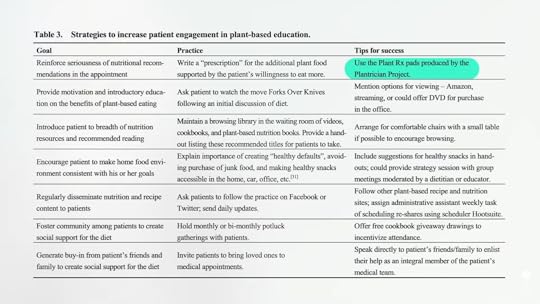
Doctors, for example, can “use the Plant Rx pads produced by the Plantrician Project” and prescribe a good website or two, like NutritionFacts.org, as seen below and at 5:50 in my video.

“While it is certainly true that many people would be resistant to fundamental dietary changes, it is equally true that millions of intelligent people motivated to preserve their health are now taking half-way measures that may provide only modest benefit—choosing leaner cuts of meat, using reduced-fat dairy products….Most of these people have neither the time nor the training to evaluate the biomedical literature themselves. Don’t they deserve honest, forthright advice when their lives are at stake? Those who wish to ignore this advice, or implement it only partially, are at liberty to do so.”
Do you want to go smoke cigarettes? Bungee jump? It’s your body, your choice. It’s up to each of us to make our own decisions as to what to eat and how to live, but we should make these choices consciously, educating ourselves about the predictable consequences of our actions.
Did I say reverse coronary heart disease? As in reverse the number one killer of men and women? I’ve got a lot of videos on the topic, and How Not to Die from Heart Disease is a good place to start.
Check out the Plantrician Project at plantricianproject.org. I am a proud supporter.
December 10, 2024
Pole Walking to Lose Weight?
Does walking with poles, also known as Nordic pole walking or “exerstriding,” beat out regular walking for depression, sleep quality, and weight loss?
Exercise recommendations for obesity have been referred to as “the mysterious case of the public health guideline that is (almost) entirely ignored.” Governmental, scientific, and professional organizations call for at least an hour of exercise a day for weight management, but “almost no obese adults meet this target.” As you can see below and at 0:32 in my video Are There Benefits of Pole Walking for Weight Loss?, surveys suggest American men and women watch television ten times more than they exercise.

For Americans with obesity, it may be even worse. Only 2 percent reach even 30 minutes a day, as you can see below and at 0:36 in my video, and the percentage exceeding an hour of exercise a day is expected to be close to zero.
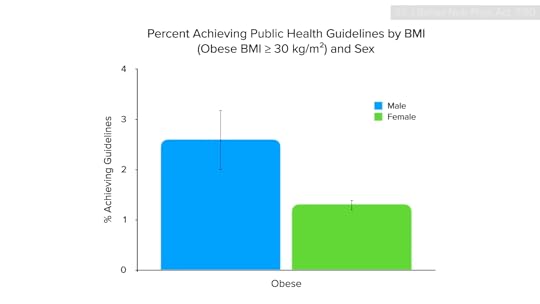
Why don’t individuals with obesity exercise more? Why don’t we just ask them? When questioned, “obese adults typically describe exercise as being unpleasant, uncomfortable and unenjoyable.” How can we break this vicious cycle, where inactivity can lead to weight gain, which can lead to further inactivity and even more weight gain? The first thing to recognize is that “it is normal and natural to be physically lazy.”
“Nothing in Biology Makes Sense Except in the Light of Evolution” is the title of a famous essay written by a noted geneticist. Laziness is in our genes. We evolved to instinctually avoid unnecessary exertion to conserve energy for survival and reproduction. These days, there’s no shortage of available fuel, yet the hard-wired inertia remains. “The vast majority of people today behave just as their ancestors by exercising only when it is fun (as a form of play) or when necessary.” Just like dietary change for weight control, the only way exercise is going to work long-term is if it becomes “a stable, ideally lifelong, activity habit.” Exercise is only effective if it’s sustainable. So, we need “to restructure our environments to require more physical activity,” like using a treadmill desk, and figure out how to make exercise more enjoyable. It should just be a walk in the park—literally, perhaps!
Some wise advice from a 1925 medical journal entry: “The best prescription to be written for a walk is to take a dog…and a friend.” Listening to your favorite music might also help. Music has been described as “a legal method” for improving peak performance and, more importantly, enhancing the enjoyment of high-intensity interval training. As you can see below and at 2:37 in my video, listening to a preferred playlist during exercise can significantly reduce your “rate of perceived exertion,” which is how hard you feel your body is working. When severely obese youth got on a treadmill and were told to go until exhaustion, with or without music, those listening to their favorite tunes “ran significantly longer,” tending to go about 5 percent longer. This was chalked up to “attentional distraction”; the music may have helped them keep their mind off feelings of fatigue. If that’s the case, listening to a podcast or audiobook might have a similar effect.
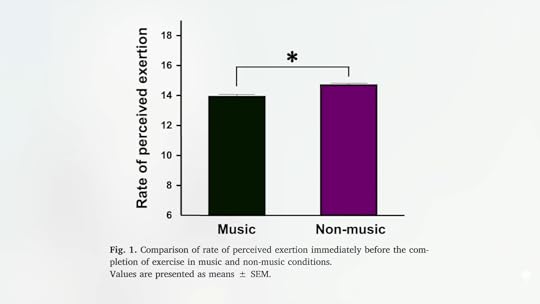
One way to up your walking game is with walking poles. So-called Nordic walking, also known as exerstriding or Viking hiking, was originally developed in Scandinavia to maintain cross-country ski athletes’ training in the summer. It’s since gained in popularity worldwide as a general fitness activity. The augmented engagement of the upper body musculature may result in an 18 to 22 percent increased calorie expenditure over walking alone (depending, in part, on your pole handling technique). Does that translate into accelerated weight loss?
Before and after studies demonstrate weight loss with pole walking, compared to a sedentary control, but what about compared to regular walking? Of the four such studies I could locate, comparing thrice weekly 40- to 60-minute sessions of Nordic pole walking to regular walking, every single one found no significant difference in body fat measures after 8 weeks, 12 weeks, another at 12 weeks, or 13 weeks. You can see the last one below and at 4:16 in my video.

There are, however, other benefits over regular walking, such as increased upper body muscle bulk, improved muscular endurance, and increased strength, as seen below and at 4:20 in my video, though not as much as was seen with resistance-band training. But, as I was writing How Not to Diet, there wasn’t any evidence of a weight-loss-enhancing effect, which is why Nordic walking didn’t make the cut. Just as we were going to press, a study was published—the first to combine Nordic walking with diet, compared to the same dietary program with regular walking. And, once again, no significant difference was found in body weight or anything else. There was a hint that those in the pole group enjoyed it more, and, in the end, exercise only works if you do it, so that may be a benefit.

There may be other benefits, too. As you can see here and at 5:05 in my video, Nordic walking beat out regular walking in terms of reducing symptoms of depression and improving sleep quality.
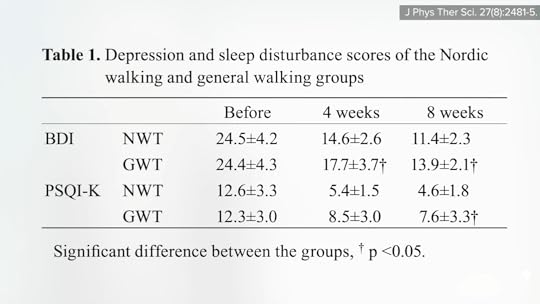
Perhaps this should not be surprising, given the greater exercise intensity of pole walking, even approaching that of jogging at higher speeds, shown below and at 5:15 in my video. And that’s where I see the role of walking poles—to fill the intensity gap between people who are ready to graduate from walking but aren’t ready for more rigorous activities, such as running. The only potential downsides are the added expense and, “reminded of Monty Python’s famous ‘ministry of silly walks’ sketch…‘feeling fairly ridiculous’ when trying Nordic walking for the first time.”
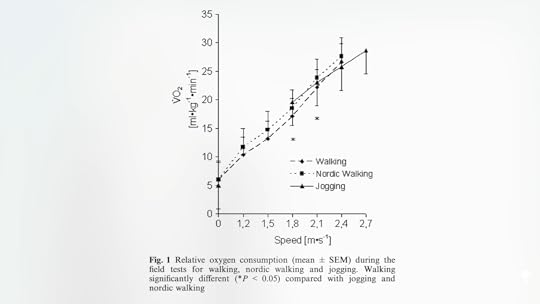
However you walk, there are a lot of benefits. Check out my video Longer Life Within Walking Distance.
Related videos include How Much Exercise to Sustain Weight Loss? and How Much Should You Exercise?.
December 5, 2024
Diets with the Lowest Carbon Footprint
Why don’t environmental groups advocate for climate-friendlier diets?
In what “was arguably the largest ever environmental protest in the world,” more than one million children in more than one hundred countries joined the “Global Climate March, demanding that governments act now to reduce climate change and global warming.” “The concerns of the young protesters are justified” and “supported by the best available science,” wrote a group of scientists and scholars. “The enormous mobilization of the Fridays for Future/Climate Strike movement shows that young people have understood the situation. As scientists and scholars, we strongly support their demand for rapid and forceful action.”
In terms of our food supply, there are a number of little tweaks that may help, like feed additives that can reduce cattle belching, but if you put them all together, according to the prestigious EAT-Lancet Commission, we’re only talking about reducing agricultural greenhouse gas emissions by about 10 percent in 2050. In contrast, if we instead switched to plant foods, “increased consumption of plant-based diets could reduce emissions by up to 80%.”
As you can see below and at 1:02 in my video Which Diets Have the Lowest Carbon Footprint?, all those cow, sheep, and goat burps only represent a fraction of the greenhouse gas emissions from animal agriculture.
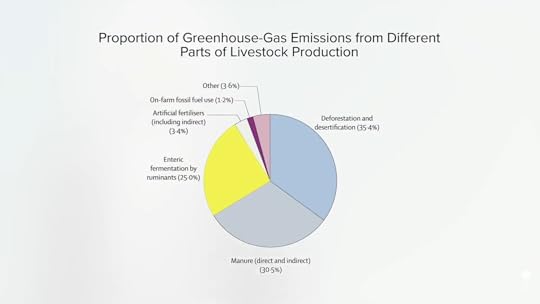
That’s why, according to the Intergovernmental Panel on Climate Change (IPCC), becoming a so-called “climate carnivore” and just cutting down on ruminant products like beef wouldn’t reduce greenhouse gas emissions as much as eating a healthier diet and limiting meat across the board. And the fewer animal products, the better, as seen below and at 1:32 in my video.
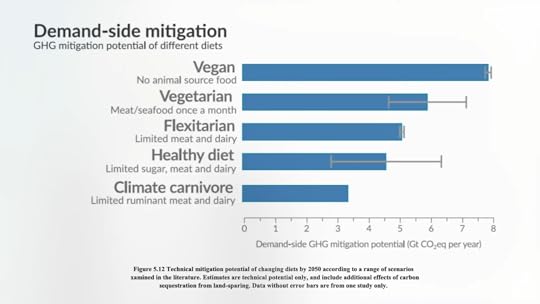
“Which diet has the least environmental impact on our planet?” A systematic review found that “the vegan diet”—eating completely plant-based—“is the optimal diet for the environment,” but it isn’t all or nothing, as you can see below and at 1:49 in my video. Even just cutting down on meat to less than an ounce or two a day could get you halfway there in terms of reducing greenhouse gas emissions.

When it comes to land use, as you can see here and at 1:56, a healthier diet, like a Mediterranean diet, may decrease your footprint by about a quarter, whereas even more plant-based diets can drop land use by 50 percent or more.

In general, diets that include meat require about 3 times more water, 13 times more fertilizer, more than twice the energy, and 40 percent more pesticides than eating patterns that don’t. If you look even more broadly at the total environmental impact of omnivorous versus vegetarian versus vegan diets and consider not just global warming, but also ocean acidification, agricultural run-off, smog, the ecotoxicity of the water and soil, and direct human toxicity of the air we breathe, the water we drink, and the soil we grow our food from, eating eggs and dairy may be 9 times worse than plants and eating eggs, dairy, and meat may be 17 times worse than sticking to plant foods. As a bonus, “replacing all animal-based items in the US diet with plant-based alternatives will add enough food to feed, in full, 350 million additional people, well above the expected benefits of eliminating all supply chain food waste.” That’s more than the U.S. population and more than if we completely irradicated food waste.
“Changing meat-eating habits may be seen as a relatively cheap and easy way to mitigate climate change, in contrast to many other climate mitigation behaviors,” factors outside our control. However, surveys suggest few “seem to recognize the option of eating less meat as a significant opportunity for helping the mitigation process.” Indeed, “research has shown that consumers often underestimate the impacts of meat consumption on the environment, in general, and on climate change, in particular…The outstanding effectiveness of the less meat option (as established by climate experts) was recognized by merely 12% of the Dutch and 6% of the American sample,” and that’s after they were prompted to assume climate change is actually happening.
“There is overwhelming scientific consensus that climate change is real and that we’re driving it,” but only about half of U.S. adults believe it. This is not by coincidence. Just like the tobacco industry tried to subvert the “overwhelming evidence that smoking and secondhand smoke cause cancer and heart disease,” companies like “Exxon orchestrated a climate change denial campaign that stalled meaningful efforts to reduce greenhouse gases for decades.”
Certainly, environmental groups should know better, though. “None of the highest profile NGOs examined…featured meat consumption and climate change among their primary climate change web campaigns.” They were all “aware of the scientific evidence connecting livestock production and meat consumption to climate change,” but, evidently, “scientific evidence alone was not sufficient to compel NGOs to adopt campaigns on the issue.” It’s like another form of denialism that can become “a negative feedback loop”; it’s an unpopular topic to discuss, so you don’t discuss it, so it remains unpopular to discuss. “This in turn deprives the issue of the attention that would be needed for it to increase in prominence” and break out.
When environmental groups have messaged about it, they “have favored asking for moderate reductions in meat consumption,” which is “notable given research demonstrating the environmental benefits of totally or nearly meat-free diets.” It could be a much more powerful lever at the individual level to go even further, but they don’t want to be seen as telling people what to do. Instead, they advocate for small changes, like turning off your computer monitor at lunchtime or printing on both sides of a sheet of paper. However, the “cumulative impact of large numbers of individuals making marginal improvements in their environmental impact will be a marginal collective improvement in environmental impact. Yet, we live at a time when we need urgent and ambitious changes.”
This is the last video in a three-part series. If you missed the first two, see Win-Win Dietary Solutions to the Climate Crisis and Which Foods Have the Lowest Carbon Footprint?.
Also check out Friday Favorites: Which Foods and Diets Have the Lowest Carbon Footprint?.
For more, I also have an older video, Diet and Climate Change: Cooking Up a Storm, and this digital download on using plant-based or cultivated meat as a climate (and pandemic) mitigation strategy.
December 3, 2024
How Heavy Is Your Food’s Carbon Footprint?
How much greenhouse gas does the production of different foods cause, measured in miles driven or lightbulb hour equivalents?
“Our eating habits are making us and the planet increasingly unhealthy—it’s a lose-lose situation.” “A global transformation of the food system is urgently needed.”
“In consideration of the mounting evidence regarding the environmental effects of foods, in 2015, the [U.S.] Dietary Guidelines Advisory Committee included for the first time a chapter focused on food safety and sustainability.” It concluded that “a dietary pattern that is higher in plantbased foods, such as vegetables, fruits, whole grains, legumes, nuts, and seeds, and lower in animalbased foods is more health promoting and is associated with lesser environmental impact than is the current average US diet.” However, unsurprisingly, “despite unprecedented public support, this and other sustainability language were not included in the final 2015–20 Dietary Guidelines published by the US Department of Health and Human Services and the US Department of Agriculture.”
The U.S. Dietary Guidelines didn’t even sufficiently stick to the science of healthy eating either. “Many national dietary guidelines do not reflect this evidence on healthy eating and include no or too lax limits for animal-source foods, particularly meat and dairy, despite an opposing evidence base.” Even if it completely ignored planetary health and just stuck to the latest evidence on healthy eating, it would have knock-on environmental benefits. Replacing animal-sourced foods with plant-based ones would not only improve nutrition and help people live longer, but it could reduce greenhouse gas emissions by up to 84 percent.
In general, “plant-based foods cause fewer adverse environmental effects” by nearly any measure. In terms of carbon footprint, all the foods that are the equivalent of driving more than a mile (1.6 km) per 4 ounces (113 g) served are animal products, as you can see below and at 1:44 in my video Which Foods Have the Lowest Carbon Footprint?.
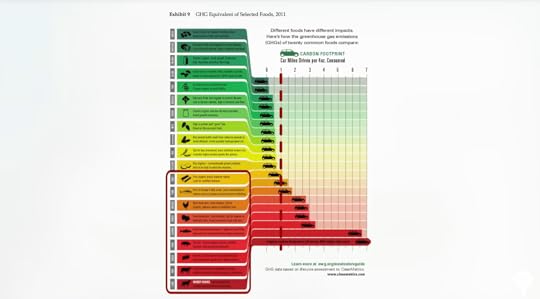
Below and at 2:05 in my video, you can see the greenhouse gas emissions from various foods. Even though something like a lamb chop or farmed fish may be the worst, eating chicken causes about five times the global warming than tropical fruit, for instance. What are the climate superstars? Legumes—beans, split peas, chickpeas, and lentils.

“For example, in the United States, substituting beans for beef at the national level could deliver up to 75% of the 2020 GHG [greenhouse gas] reduction target and spare an area of land 1.5 times the size of California,” not to mention health benefits. And it isn’t just greenhouse gases. “To produce 1 kg [2.2 lbs] of protein from kidney beans required approximately eighteen times less land, ten times less water, nine times less fuel, twelve times less fertilizer and ten times less pesticide in comparison to producing 1 kg [2.2 lbs] of protein from beef.”
So, yes, according to the prestigious EAT-Lancet Commission, more plant-based may be better, but even “a shift towards a dietary pattern emphasizing whole grains, fruits, vegetables, nuts, and legumes without necessarily becoming a strict vegan, will be beneficial.” In Europe, for example, researchers found that just “halving the consumption of meat, dairy products, and eggs in the European Union would achieve a 40% reduction in nitrogen emissions, 25–40% reduction in greenhouse gas emissions and 23% per capita less use of cropland for food production. In addition, the dietary changes would also lower health risks,” reducing cardiovascular mortality, which is Europe’s leading cause of death.
“However, minimizing environmental impacts does not necessarily maximize human health.” Yes, as you can see below and at 3:33 in my video, animal products, including dairy, eggs, fish, and other meat, release significantly more greenhouse gas per serving than foods from plants, but eating added sugar and oil won’t do your own body any favors.
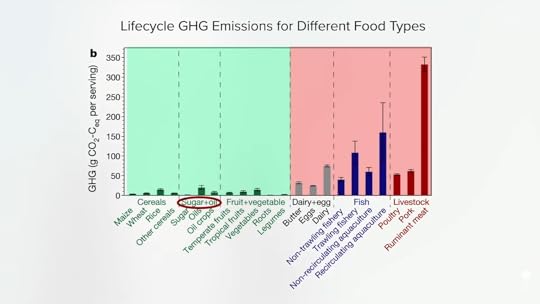
In California, including more animal products in your diet requires an additional 10,000 quarts/liters of water each week. So, that’s like taking 150 more showers in seven days. As you can see below and at 4:00 in my video, skipping meat just on weekdays could conserve thousands of gallons of water a week, compared to eating meat every day, as well as cut your daily carbon footprint and total ecological footprint by about 40 percent.
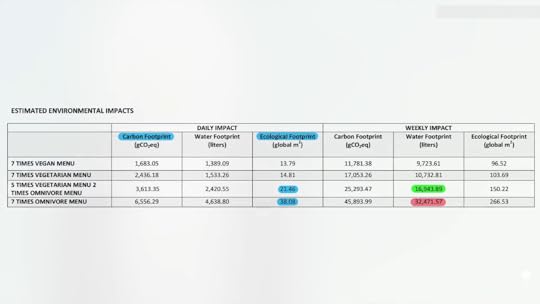
Some countries are actually doing something about it. For example, the “Chinese government has outlined a plan to reduce its citizens’ meat consumption by 50%,” whereas much of the rest of the world appears to be doing the complete opposite, pumping billions of taxpayer dollars into subsidizing the meat, dairy, and egg industries, as you can see below and at 4:15 in my video.

We can certainly all try to do our part. However, an obstacle to dietary change may be that “consumers underestimate” the environmental impacts of different types of food. Labeling may help. For example, imagine picking up a can of beef noodle soup and seeing the image below, shown at 4:38 in my video.

The carbon footprint of a single half-cup serving of beef noodle soup is like leaving on a light for 39 hours straight—and not an eco-bulb, but an old-school, 100-watt incandescent bulb. Compare that to eating a meat-free vegetable soup. Between the two, there’s a difference of 34 light-bulb hours, as you can see below and at 4:50 in my video. You can imagine someone getting on your case for unnecessarily leaving on a light for 34 minutes, but this is 34 hours wasted just from eating half a cup (120 ml) of a meaty soup rather than a meat-free vegetable soup.

This is the second in a three-video series. If you missed the first one, check out Friday Favorites: Win-Win Dietary Solutions to the Climate Crisis. Stay tuned for Which Diets Have the Lowest Carbon Footprint?. Also check: Friday Favorites: Which Foods and Diets Have the Lowest Carbon Footprint?.
For more, see my older video Diet and Climate Change: Cooking Up a Storm and a [digital download] on using plant-based or cultivated meat as a climate (and pandemic) mitigation strategy.
November 28, 2024
Eating to Fight the Climate Crisis
The EAT-Lancet Commission lays out the best diet for human and planetary health.
“Scientists have a moral obligation to clearly warn humanity of any catastrophic threat and to ‘tell it like it is.’” In November 2019, more than 11,000 scientists from 150 countries declared “clearly and unequivocally that planet Earth is facing a climate emergency.” As you can see in a series of graphs starting at 0:33 in my video Win-Win Dietary Solutions to the Climate Crisis, CO2 levels are rising and the glaciers are melting, as is Antarctica. The oceans are getting hotter, and more acidic. Sea levels are rising, and extreme weather events are escalating. Yes, the use of fossil fuels is going up, for air travel, for example, but so is per capita meat consumption. In fact, one of the solutions offered by scientists to help the climate crisis is “eating mostly plant-based foods while reducing the global consumption of animal products….”
What makes “designing a sustainable diet” so easy is that “the dietary advice is the same: eat less meat.” It’s good for our personal health (by reducing the risk of our number one killer, for instance), as well as planetary health. As you can see below and at 1:24 in my video, the least healthy foods also cause the worst environmental impact.

Indeed, the foods with the most nutrition just so happen to be the foods that cause the lowest greenhouse gas emissions, as shown below and at 1:31 in my video, so the effect is a win-win.
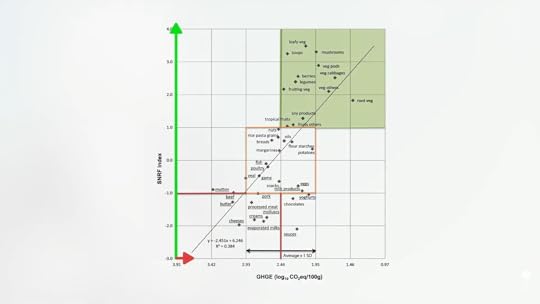
Let’s put it all together. If we are to “redesign the global food system for human and planetary health,” which is to say human health, planetary health, and future human health, what would it look like? Enter the EAT-Lancet Commission. What was the “result of more than 2 years of collaboration between 37 experts from 16 countries”? Suggesting a cut in total meat consumption down to no more than an ounce a day (28 g), which is around the weight of a single chicken nugget, and, concurrently, a dramatic increase in our intakes of legumes (beans, split peas, chickpeas, and lentils), vegetables, nuts, and fruits. We aren’t only in a climate crisis, but a health crisis, too. “Unhealthy diets pose a greater risk to morbidity and mortality than does unsafe sex, and alcohol, drug, and tobacco use combined.” But we can address both crises at the same time by “increasing consumption of plant-based foods and substantially reducing our consumption of animal source foods.”
Eating such a diet could save the lives of more than 10 million people a year. It may also help save the world. The Paris Agreement had set out a boundary condition, an aspirational goal for a carbon budget to help prevent catastrophic impacts. “Staying within the boundary for climate change can be achieved by consuming plant-based diets.”
What’s more, “the economic value of the health benefits associated with more plant-based diets is comparable with, or exceeds, the value of the environmental benefits….” Just the healthcare benefits alone of a healthy global diet that’s predominantly plant-based, vegetarian, or vegan could exceed the price of the carbon saved, as you can see below and at 3:11 in my video. We’re talking up to $30 trillion a year saved from just the health benefits of more healthful eating.
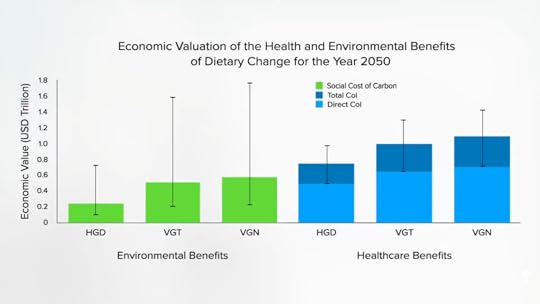
Now, if the health of yourself, the planet, and your loved ones doesn’t quite motivate you, consider you may also be facing threats to the global beer supply. The title of the paper tells the story: “Decreases in Global Beer Supply Due to Extreme Drought and Heat.”
And healthier diets don’t just reduce greenhouse gas emissions. “Livestock production is the single largest driver of habitat loss,” so reducing meat consumption is also the key to biodiversity conservation. Researchers “suggest…reducing demand for animal-based food products and increasing proportions of plant-based foods in diets, the latter ideally to a global average of 90% of food consumed.” As well, “livestock production is also a leading cause of climate change, soil loss, and water and nutrient pollution,” yet it appears to be “a blind spot in water policy.” “Despite the fact that animal products form the single most important factor in humanity’s WF [water footprint], water managers never talk about meat or dairy.”
It isn’t only animal products, though. Yes, at least 80 percent of the deforestation in the Amazon is to raise cattle and grow feed crops like soybeans to export to other farm animals, but it’s also to make vegetable oil, mostly from palm and soy. Both crops have been expanding, “resulting in massive deforestation accompanied by declines in biodiversity and the release of sequestered carbon into the atmosphere…It will be particularly egregious if that deforestation takes place for the sake of junk food….”
Not everyone agrees that we should be moving to healthier diets, though. The World Health Organization actually pulled out of the EAT-Lancet Commission that “promotes global move to plant-based foods.” See, if we “focused on promoting predominantly plant-based foods, and excluding foods deemed unhealthy, including meat and other animal-based foods,” such a diet could save 10 million lives a year and $30 trillion in healthcare costs, and help save the entire planet, but it “could lead to the loss of…jobs linked to animal husbandry and the production of ‘unhealthy’ foods….”
So Which Foods Have the Lowest Carbon Footprint? Find out next, then stay tuned for Which Diets Have the Lowest Carbon Footprint?.
Before this video, I think the only global warming video I had to date was Diet and Climate Change: Cooking Up a Storm. I’m pleased I could add to this important topic.
One way to reduce the climate impact of meat is to switch to plant-based or cultivated meat. I did a webinar on it, and you can get the digital download here.
November 26, 2024
Junk Food in Hospitals
Why is hospital food so unhealthy?
“Put in stark terms, CVD [cardiovascular disease] claims 1 American life every 39 seconds and is responsible for more deaths annually than cancer, chronic lower respiratory disease, and accidents combined.” For most heart attack deaths, you just keel over. Sudden cardiac death “is the first manifestation of CHD [coronary heart disease] for the majority of individuals, particularly among women.” So, “for many of these sudden death victims, their demise was the first indication of the presence of coronary heart disease.” They didn’t even know they had heart disease. That’s why an ounce of prevention is worth way more than a pound of cure—because there is no cure for death.
That’s also why the prevention of sudden cardiac death “remains a major public health challenge” because most people don’t even know they’re at risk. However, we’ve known for more than half a century, when we first started autopsying young servicemen who died during the Korean War, that coronary artery disease begins in our youth, even among young children. So, “business as usual…simply is not going to yield the improvements necessary to radically improve the CV [cardiovascular] health of the United States” and around the world.
There is good news, though. A “low-risk lifestyle (not smoking, exercising regularly, having a prudent diet, and maintaining a healthy weight)” may be able to eliminate the vast majority of the risk for sudden cardiac death. “The time is now long overdue to start aggressive preventive cardiovascular disease programs in our schools, our homes, and our worksites.” How about starting in our hospitals?
As I discuss in my video Hospitals Profit on Junk Food, a significant percentage of hospitals surveyed had fast-food restaurants inside them, with Krispy Kreme topping the list. Brilliant marketing, given that “families surveyed at the hospital with McDonald’s were…twice as likely to think McDonald’s was healthy, as compared to families at the hospitals without McDonald’s.” After all, McDonald’s was in the hospital.
What about food served in hospital cafeterias? Any better? Researchers analyzed 384 entrees from 14 children’s hospitals in California, and only 7 percent “were classified as healthy.” And, just in case someone chose the rare healthy option, 81 percent of eating venues in children’s hospitals had junky “high-calorie impulse items, such as ice cream freezers, cookies, and candy, at or near the checkout register” and 38 percent “had signs encouraging unhealthy eating.” Why would they do that?
If you ask hospital cafeteria managers, “less than a quarter (4 of 17) of respondents reported that the hospital followed nutrition standards for food offered in the cafeteria.” “Nutrition is not a top priority.” It’s the same reason unhealthy food is sold anywhere else: “pressure on food service departments for cafeterias to generate profit.”
“Increased emphasis…[is] placed on running a hospital foodservice department as a profit center”—a bigger and “bigger profit center,” that is. It’s such a metaphor for our sickness-care system in general, where healthy, treat-the-cause approaches are eclipsed by the pills and procedures that bring in the most money.
What do you expect from the private sector? Public hospitals don’t seem to be much better. A 2019 analysis of veterans’ hospitals found that “all VA Hospitals contain vending machines providing a majority of soda, candy, and junk foods that directly conflict with healthy food choice recommendations from US governing health bodies,” such that, ironically, “hospital visits could theoretically promote worse health….An important question that should be posed is why are any soda or candy machines available at our VA hospitals? Are we trading the health of our veterans for profits?”
Maybe it’s time to ban junk food on hospital premises. “On daily rounds, it is appalling to see patients…gorging on crisps [potato chips], confectionery [candy], sports drinks, and cola—the very food items that may have contributed to their admission in the first place…It is obscene that many hospitals continue to have…fast food franchises on site, as well as corridors littered with vending machines selling junk food. Such practice legitimizes the acceptability and consumption of such foods in the daily diet…The obesity epidemic represents a public health crisis, but it is a public health scandal that by legitimizing junk food hospitals have themselves become a risk factor for diet-related disease by perpetuating the revolving door of healthcare…It’s time to stop selling sickness on the hospital grounds.”
What message do residents receive when they are fed pizza and soda at grand rounds? We need a healthcare system with “more Hippocrates, less hypocrisy.”
For more on how the profit motive is degrading our health, see related posts below.
November 21, 2024
Celebrating Native American Cuisine with Chef Lois Ellen Frank, Ph.D.

Please tell us a little about yourself and your work.
My name is Lois Ellen Frank, and I am a Santa Fe, New Mexico-based chef cooking alongside Chef Walter Whitewater at Red Mesa Cuisine, LLC, a small catering company specializing in Native American cuisine. We focus on Indigenous Cuisine and Cultural Education, and work on the revitalization of ancestral Native American cuisine. We incorporate a modern twist and prepare foods using ingredients focused on health and wellness. Together, we have been working with communities in the Southwest for more than 30 years. Our newest cookbook, Seed to Plate, Soil to Sky: Modern Plant Based Recipes Using Native American Ingredients, was released in the fall of 2023 and focuses on The Magic Eight, eight plants that Native Peoples shared with the world. We also work with the Physicians Committee for Responsible Medicine (PCRM) on The Power to Heal Diabetes: Food for Life in Indian Country program, which uses the ancestral Native American diet for health and wellness in Native American communities throughout the United States to re-indigenize, revitalize, and re-introduce healthy ancestral foods back the diet. (Learn more at www.nativepowerplate.org.)
Can you please discuss the re-indigenizing food movement in the Native American community? How can this promote better health and wellness?
By using healthy foods from the ancestral past, including The Magic Eight (corn, beans, squash, chiles, tomatoes, potatoes, vanilla, and cacao), and increasing the amount of plant-based foods in the current Standard American Diet (SAD), the Native American foods movement works towards reclaiming ancestral foods for wellness; revitalizing traditional cooking techniques and recipes associated with them; educating and teaching children, teens, college students, and adults about the importance of traditional foods and the role they play in health and wellness; developing well-rounded culinary professionals in both the theory and technique of cuisine; developing specialized workshops tailored toward individual and group needs that include (but are not limited to) health, nutrition, team-building, youth development, and technical skill enhancement, as well as other social and professional development; creating an awareness of traditional and contemporary Native American culinary customs and technologies that include concepts of sustainable agriculture, health, and nutrition; and emphasizing how the health benefits of an ancestral plant-based diet can improve health and connect community members to healthy ancestral foods.
Can you please tell us about The Magic Eight? What are they, and what is the history of these foods?
The Magic Eight are eight plants that Native Peoples gave to the world: corn, beans, squash, chiles, tomatoes, potatoes, vanilla, and cacao. Prior to 1492, these plants existed only in the Americas. Once these plants were introduced to cultures of the world outside of the Americas, their cuisines were changed forever. And these eight plants, now found in almost every cuisine all over the world, are inherently Native American, an important part of our cuisine, and the foundation to the foods we cook at Red Mesa Cuisine. Think about this: The Italians didn’t have the tomato until after 1492. The Irish didn’t have the potato. In Britain, they had fish, but no chips. The Russians didn’t have the potato, nor did they have distilled spirits from the potato. There were no chiles in any East Indian cuisine dishes, including curries, and no chiles existed in any Asian cuisines at all. As a matter of fact, chiles weren’t introduced into South Asia until the 1500s when they would come to dominate the world spice trade in the sixteenth century. Vanilla and cacao weren’t used in any confection dishes prior to 1492. The world cuisines as we know them today were completely different!
How were these Magic Eight foods used in Native American cuisine historically versus in modern-day cuisine?
These foods were used in a variety of ways. Corn, beans, and squash were (and still are) often served together. Chef Walter thinks of them as a family. They are grown together and eaten together. Chiles, tomatoes, and potatoes were also often used together in the past, as they are today, as their flavors work well together and they are nightshade plants. Vanilla and cacao are considered to be the sweet sisters and are often paired together. In our cookbook Seed to Plate, Soil to Sky, we have shared some very traditional ancestral recipes featuring these eight amazing plants and introduced some new and creative ways to eat them in both savory and sweet dishes.
Is there a way that local food systems can be better supported so more of these plants can become cultivated and accessible?
We are very blessed in New Mexico. There are lots of farmers in Northern New Mexico where I live, and they grow many varieties of corn, beans, squashes, chiles, tomatoes, and potatoes, so it is easy for someone living here to purchase many of these plants and incorporate them into their diets. It’s also easy to grow your own garden here, even in a small space. Buying from the local Santa Fe farmers market helps to support the farmers and perpetuate the growing of these important crops. And, more and more Native American communities are implementing gardens for their community members and growing traditional varieties of these amazing plants, making these foods accessible and affordable to those who really need them. Programs such as WIC, SNAP-Ed, and FDPIR are including New Mexico-grown produce as part of their distribution programs, and Chef Walter and I are working hard to teach people how to use the plants in delicious and nutritious dishes.
Are there other lesser-known plants that are used in Native American cuisine that you would like to highlight?
Native American cuisine is regional, so a plant that is common to one community in one region of the United States might not be common in another. It also depends on what grows in each region. For instance, wild rice grows in the lake regions and is a very important and sacred food to the communities living there. Where I live, wild plant foods play an important part of the diet. I love to eat wild lettuces and spinach, wild purslane, and edible flowers. There are many herbs from this region that play an important part in this cuisine––both wild and cultivated plants. I think the more plants, the better. I love plants, and Chef Walter and I try to honor the plants and eat seasonally when they are available. We also use culinary ash to increase the nutrients and minerals in some of our corn dishes.
What does Native American Heritage Month mean to you?
That’s a tough question. Food to me is medicine. I try to practice gratefulness and appreciation for the bounty of foods and plants in my life everyday––not just one month a year. But, if people can appreciate the plants that Native Americans shared with the world and honor the Native American contribution to the foods we eat every day, then that makes me happy. Many people are unaware of the contribution Native Peoples have made to the foods we eat each day, including corn, beans, squash, chiles, tomatoes, potatoes, vanilla, and cacao. When these foods are prepared in a healthy way and the Traditional Ecological knowledge (TEK) surrounding these plants is revitalized, then so is everything associated with them. And when people are fed these foods, they are nurtured, and the knowledge and importance of this ancestral knowledge is honored.
Delicious Pinto Bean and Spinach TacosThis recipe, adapted from Seed to Plate, Soil to Sky, is a wonderful combination of fresh spinach greens sautéed with cooked beans. It is easy to make for a healthy and nutritious meal. I use organic spinach, which is now readily available, and if I don’t want to cook a whole pot of fresh beans, organic canned pinto beans from the grocery store.
2 teaspoons of Roasted Garlic (approximately 8 cloves)3 medium Roma tomatoes, diced (approximately 1 cup)½ large white onion, diced (approximately 2/3 cup)3 cups coarsely chopped fresh spinach1½ cups cooked pinto beans or one 15.5 oz canPinch of freshly ground black pepper
Heat a small cast iron skillet over high heat until hot.
Prepare the Roasted Garlic.
Heat a medium- to large-sized cast iron pan over medium-high heat until it is hot, then add the Roasted Garlic, tomatoes, and onion, and cook for 2 to 3 minutes, stirring constantly to prevent burning. Add the spinach, and cook for another 2 minutes. Then, add the pinto beans and a pinch of black pepper, and cook for 2 minutes, stirring constantly to prevent burning.
Serve in your favorite corn or flour tortillas. (I like this dish with either corn tortillas or gordita-sized flour tortillas.)
Top with freshly made pico de gallo salsa and homemade guacamole, if desired. Serve immediately.
Makes 6 tacos.
You can find Chef Lois Ellen Frank here.
November 19, 2024
Cannabis and Cars
Did traffic fatalities increase or decrease after cannabis legalization?
Is cannabis-impaired driving a public health and safety concern? Well, the number of tickets for cannabis-impaired driving went up in Washington State after legalization, as did the proportion of drivers in fatal car crashes in Colorado who tested positive for marijuana use. But, in both cases, this “may simply reflect a general increase in marijuana use” overall. It doesn’t mean that cannabis is causing the crashes, as I discuss in my video The Effects of Marijuana on Car Accidents.
There is a lot of evidence correlating marijuana use with car accidents, but who uses marijuana? Mostly young people and males. And guess who has a higher crash risk regardless of what they smoke? Young people and males. However, even taking that into account, it does seem that “roughly 20–30% of traffic crashes involving cannabis use occur because of the cannabis use.” But, to put that in perspective, that number is more like 85 percent when it comes to alcohol.
Aren’t cannabis crashes low-velocity fender-benders from an impaired driver going like five miles an hour? “After a systematic review of the literature,” a compilation of studies “examining acute cannabis consumption and motor vehicle collisions…found a near doubling of the risk of a driver being involved in a motor vehicle collision resulting in serious injury or death.” So, that’s pretty serious, but alcohol is even worse. Cannabis may double or triple the risk of car crashes, but alcohol may multiply the risk 6- to 15-fold. The combination may be even worse—25 times the odds of a fatal car crash involvement when testing positive for both cannabis and alcohol.
The “safety consequence of increased incidence of cannabis intoxication” when driving is listed as one of the “three primary reasons for concern about legalized cannabis….” Well, what happened in the U.S. states where marijuana was legalized? How much did traffic fatalities go up? They didn’t. In fact, they went down. What? “Why does legalizing medical marijuana reduce traffic fatalities?” Because of reduced alcohol consumption. It was found that “the legalization of medical marijuana is associated with reduced alcohol consumption, especially among young adults.” So, there was more drugged driving, but less drunk driving—and drunk driving is so much worse that fatalities went down overall.
So, perhaps we’d also see less liver disease and less alcohol-induced brain damage, as cannabis substitutes for some of the alcohol use. Indeed, researchers argued that “cannabis was unlikely to produce as much harm as alcohol because, unlike alcohol, cannabis did not cause liver and other gastrointestinal diseases, it was not fatal in overdoses, it did not appear to be as neurotoxic as alcohol, and it was not as potent a cause of car crashes as alcohol.”
“The health problems reported by cannabis dependent persons—e.g. bronchitis and impaired memory—are much less serious on average than those reported by persons who are alcohol dependent (e.g. delirium, liver disease, gastritis) but this does not mean that cannabis dependence is a minor problem.” When public health authorities bring that up, though, they may be criticized. In the 1940s and 1950s in the United States, for instance, after the repeal of Prohibition, we needed to warn people about the problems of heavy drinking, liver cirrhosis, and alcoholism, but some dismissed the concerns as if they were just “temperance propaganda.” We now see a similar situation, where the public health profession wants to educate people about the adverse health effects of cannabis but is dismissed as “reefer madness” hysterics.
Still, it’s important to put these adverse health effects in perspective. How does the safety of cannabis stack up against alcohol and tobacco? According to the Centers for Disease Control and Prevention (CDC), “alcohol is linked to approximately 88,000 deaths per year,” whereas “there are no reported deaths due to cannabis.” (They’re from things like car accidents.) What’s more, they even go down when more people smoke pot because alcohol is so much worse. “With hindsight, we can clearly see the enormous problems that have been caused to many individuals and to society by tobacco and alcohol”—both legal drugs. “If asked to decide today which psychoactive drugs should be legal, cannabis (which rarely kills people) might well be judged as being comparatively benign” and may be much higher on the list.
I have many other videos on cannabis if you’re interested. Check out the related posts below.
I first released these videos in a webinar, and you can find them all on a digital download here.



